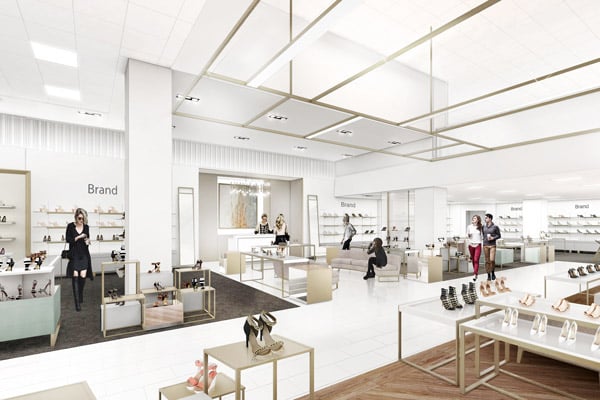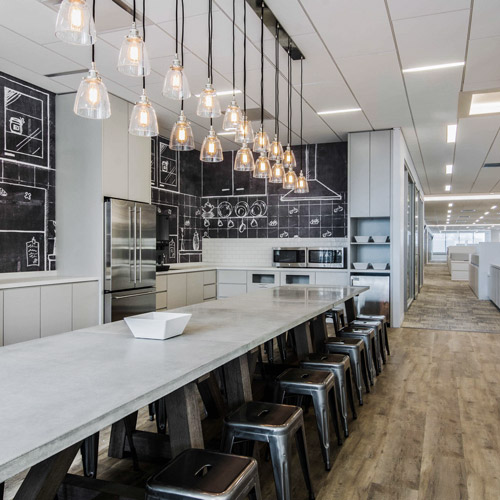When you work for one of the fastest-growing retailers in the world and your job is managing its real estate, you’re never in one place for very long. Richard Hamori, senior vice president of store planning and design at Hudson’s Bay Company (HBC), tries to stay equally as flexible with his time as he does with his various projects.
The Toronto-based company, founded in 1670, has 10 retail banners and more than 460 stores around the world. In North America, Hudson’s Bay, Lord & Taylor, and Saks Fifth Avenue lead the company’s impressive portfolio. Its European banners include GALERIA Kaufhof, the largest department store group in Germany, and Galeria INNO, the only department store group in Belgium.
“I do travel a lot,” says Hamori, who spends two weeks of every month in Europe and the other two in North America. “It’s a challenge to make sure I spend enough time with teams to provide direction when direction is needed and walk them through the different projects and programs.”
Hamori is currently shepherding the renovation of the Manhasset, New York, Lord & Taylor store, which is due to be completed in 2018. His focus there is necessary, given that he deals with multiple municipalities on the project, which includes a complete revamp of the parking structure.

Hamori says a key to his job is balancing uniqueness and uniformity for each banner—something he has shown a knack for since joining Hudson’s Bay in 2004. He led the expansions of both the Hudson’s Bay and Saks OFF 5th banners throughout Europe. He and his team are also helping launch the Hudson’s Bay banner in the Netherlands. This year, they will expand the OFF 5th brand and spearhead the launch of five new European stores in 2017.
“Part of my job is to be the brand police for the look and feel of each of banner,” Hamori explains. “Each has its own DNA, and we have to maintain that.”
That’s not always as easy as it sounds, especially when teams from each banner exchange new ideas with one another and look to apply them.
“The challenge is pulling back and knowing what the operational needs are for each business, and understanding whether what works in one banner can transport internationally to another banner,” he says.
There are also different physical spaces to consider.
“We have what we call ‘prototype spaces’ for various sizes of buildings,” Hamori explains. “These prototypes help us establish how big or small, for example, the cosmetics department can be without losing significance. We can see how the puzzle fits together so we can deliver a compelling message to the consumer.”

Even with these prototypes to guide them, Hamori says fitting all the pieces together presents another obstacle.
“A retail box is often hardly a box,” he says. “European buildings are not the standard department store buildings you see in North America. They’re landmarks that have some real history and significance. And often it’s not just one building, but rather multiple buildings.”
A new project in Amsterdam, for instance, encompassed four separate buildings.
“We considered how we could present the brand so the customer reads it as one piece— which we can accomplish through signage, canopies, banners, and other visual enhancements,” he says. “You have to present a single message.”
Hamori will be spending a lot of time in the Netherlands throughout 2017. He says the company is opening and renovating 10 stores there, including the flagship Hudson’s Bay location in Amsterdam and another flagship store in Rotterdam. In 2018, he says, there are plans to open up to 10 more locations.
“It’s not so much that everyone in the Netherlands has more money to spend,” he says. “It’s more that there is an economic opportunity for our company to be there. We also wanted to expand our European operations and bring one of our existing brands to the Netherlands.”

Following HBC’s established brand matrix for each department store banner helps Hamori maintain brand consistency no matter where in the world he is and in which kind of space he works. Each matrix includes visual cues that communicate the specific store brand to the consumer. Within each brand matrix is a second matrix based on physical space. Flagship stores, for instance, have their own matrix because—like those historic European buildings—renovations are governed by strict zoning laws.
At the mention of flagship stores, Hamori is reminded of another challenge that only grows bigger each year: vendors aggressively growing their own chains of branded boutique stores. In some cases, these stores are just around the corner from an HBC store. This, of course, leads to more vendor meetings than ever before.
“When we bring a brand such as Chanel or Tommy Hilfiger into one of our platforms, we look at that vendor’s DNA to gain an understanding of it,” he says. “Then, we have dialogue with the vendors about where we’d like to tweak things to better suit our environment. ‘Is there a way to display and integrate the brand within our design language to create newness and uniqueness?’”
These aren’t always easy conversations, but Hamori’s team is skillful at presenting the challenge to the vendor, and the results are almost always positive for both parties. More importantly, it’s a proactive way to tackle an issue, an approach he takes in all his responsibilities—whether on this continent or in Europe.
CONTINENTAL COMMONALITIES
For a world-traveling executive whose job has so many variables, Richard Hamori keeps a remarkably well-organized schedule.
“The key is establishing rules of engagement,” says the Hudson’s Bay Company senior vice president of store planning and design.
Hamori divides his time equally between Europe and North America, and says his schedule on each continent consists of virtually the same thing—lots and lots of meetings.
“I meet with merchandisers and leadership,” he says. “I’m looking at each program that’s underway and each meeting with construction and facilities groups. I’m also meeting with engineering and architecture firms.”
Hamori also consults with procurement groups to make sure the right store fixtures and merchandisers are in place.
“It’s really about providing leadership to the teams, to ensure we’re all moving in the right direction,” he says. “I love sketching out concepts, but I don’t have as much time for that now. I need to provide clear leadership and police our brand DNAs while making sure we stretch the creative envelope and evolve at the same time.”


